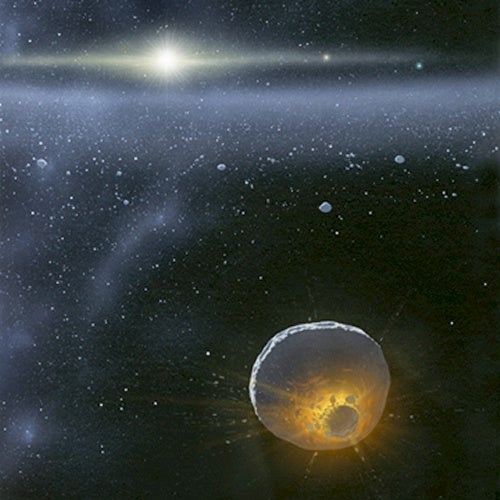Planetary scientists continue to debate what Sedna’s presence says about the history of our solar system. Now, S. Alan Stern of the Southwest Research Institute in Boulder, Colorado, says large bodies may have formed much farther out than previously thought — and Sedna may be only the first of many such objects found in the solar system’s hinterlands.
“If this is actually what happened, it would indicate that our solar system’s planet factory operated across a much larger region,” says Stern.
Since Caltech astronomer Mike Brown and colleagues Chad Trujillo (Gemini Observatory) and David Rabinowitz (Yale University) announced Sedna’s discovery last year, planetary scientists have struggled to explain its origins. Estimated to be about 1,120 miles (1,800 kilometers) across, Sedna travels an extremely distant and elongated path, swinging from 76 times Earth’s distance from the Sun to more than 940 times as far away in a single 11,500-year orbit.
The discoverers suggested Sedna formed near the Sun, in the region between Jupiter and Neptune, and gravitational encounters with other bodies launched it into its current orbit. The trouble is, Sedna never comes closer than about twice the distance to Pluto.
Based on computer simulations, Brown’s team, as well as astronomers Alessandro Morbidelli (Observatory of Nice, France) and Hal Levison (Southwest Research Institute), suggest Sedna was kicked into its current track when a Sun-size star grazed our solar system shortly after the planets began to form. They argue Sedna marks the inner edge of the Oort comet cloud because this was exactly the kind of event required to emplace the comets.
Scott Kenyon of the Smithsonian Astrophysical Observatory in Cambridge, Massachusetts, and Benjamin Bromley of the University of Utah in Salt Lake City brought a twist to this idea. Sedna, they say, could have formed around the interloper star, only to be captured into our solar system during the close encounter.
Stern’s take on the subject appears in the January 2005 issue of The Astronomical Journal. “Clearly, Sedna cannot have formed in its present eccentric and inclined orbit,” he writes. Random encounters with icy, boulder-size, “building blocks” occur at about 2,200 mph (3,600 km/h, or 1 km/s). Such speeds would shatter the objects rather than allow them to accrete into a single body.
Stern agrees Sedna’s orbit has been altered, but he notes this doesn’t necessarily mean Sedna formed closer to the Sun and then moved outward. Instead, Sedna might have formed where it is. If so, then the close stellar encounter modified only its orbital eccentricity and inclination, not its distance from the Sun.
Stern applied a planetary-accretion computer model he developed in the late 1990s for studies of how Kuiper Belt objects formed. He used the software to test the idea Sedna-size objects could form by accretion of smaller bodies at 75 and 500 astronomical units (AU), which correspond to Sedna’s closest and average distance from the Sun. He also assumed the solar nebula was of similar extent as those found around many nearby middle-age stars, such the well-known 1,500-AU-wide disk surrounding Beta Pictoris.
“The model … found objects as large, or even larger, than Sedna could easily form in circular orbits at distances of 75 to 500 AU, and that their formation time could have been fairly short — just a few percent the age of the solar system,” says Stern. Moreover, the simulations show additional objects reached this size not long after the first one appeared. “If Sedna did form this far out, it is likely to be accompanied by a cohort of other large planetoids in this very distant region of the solar system.”
“There is no shortage of ideas for the formation of Sedna these days,” says codiscoverer Mike Brown. “At this point all of them are plausible, and we have no way of knowing which is most likely to be correct.”
Nevertheless, notes Brown, every single idea about Sedna’s formation makes predictions about what else astronomers will find in the distant reaches of the solar system. Stern’s hypothesis, for example, suggests many large objects exist in distant, circular orbits.
“In the next decade or so, when we have found perhaps a dozen objects at the distance of Sedna, I think we will be able to definitively say how they got there,” Brown predicts. “Until then, it’s great that people keep coming up with new ideas like this that we will be able to test.”










